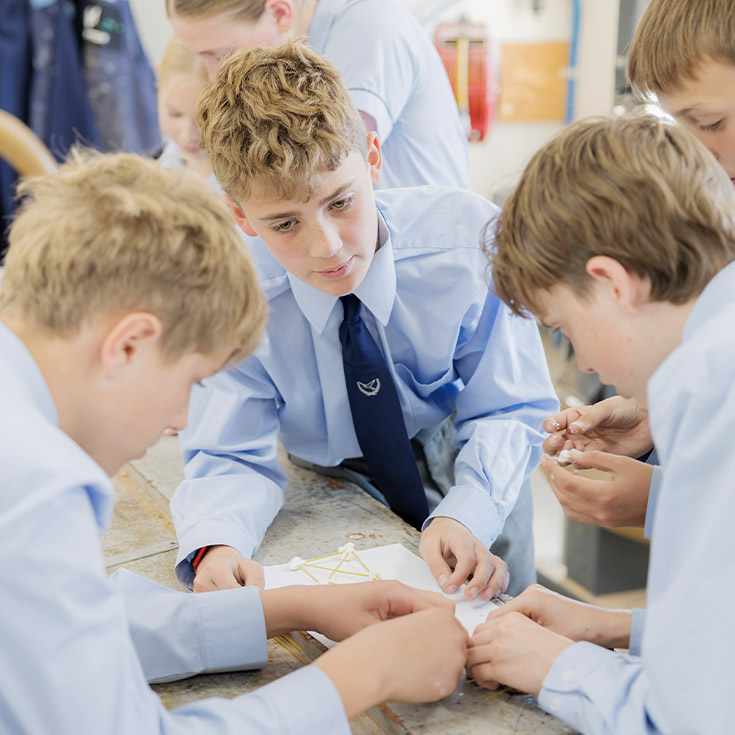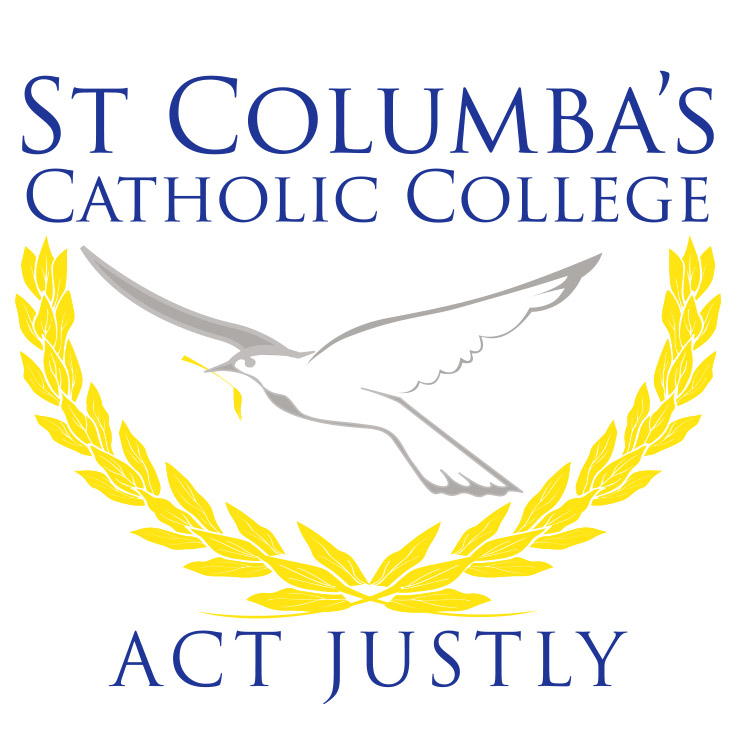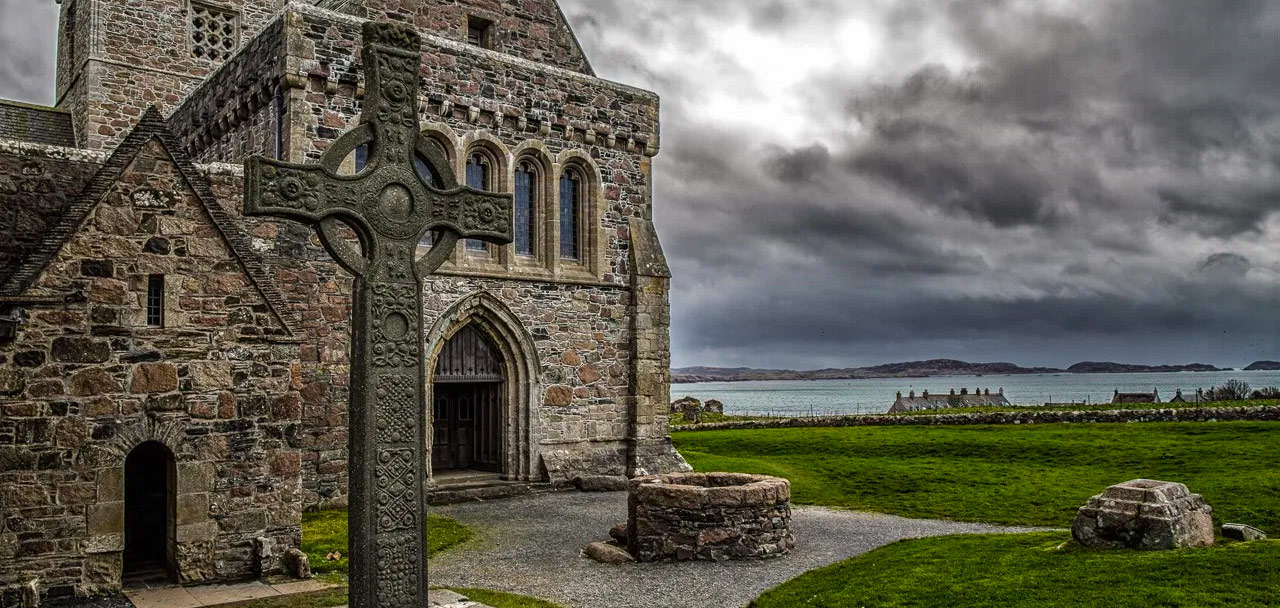To act justly, to love tenderly and to walk humbly with our God.
St Columba’s is proud to be part of Catholic Schools Parramatta Diocese's system of 80 Catholic primary and secondary schools operating across Western Sydney and the Blue Mountains, providing more than 43,500 students with a high-quality, low fee Catholic education.
At St Columba’s Catholic College we strive for the full human development of our students, grounded in our Catholic faith and tradition. We are known for our vibrant community, commitment to justice, and the outstanding achievements of our young people.

Inspired by the example of St Columba, we commit ourselves to:
Our school crest
The St Columba’s Catholic College crest features a dove with olive branches.
The dove reminds us of our namesake St Columba (in Irish, Columcille) which translates to mean ‘the dove of the Church.’ The dove is also a symbol of the Holy Spirit. The olive branches represent our aspiration to be peacemakers.
Together, these symbols proclaim the essence of St Columba’s mission: ‘to act justly, to love tenderly and to walk humbly with our God'.
Our school crest

Our history
Named for an important Gaelic saint, St Columba’s has provided quality Catholic secondary education for more than 40 years.
St Columba’s Catholic College was established in 1979. Our sandstone campus, built in neo-Gothic style, originally served as a seminary that trained candidates for the priesthood from 1909-1977.
When the seminary closed, our school initially opened to enrol students for Year 7-10. Sr Anne Henson was the founding principal. In 1993, our school restructured to enrol the first Year 12 class.
In 1997, the school opened Iona Chapel, a space for prayer, reflection, and liturgy for the whole school community.
Our new Creative Hub, a state-of-the-art educational space, is presently under construction.
Today, St Columba’s enrols 1080 students from across the Blue Mountains and Western Sydney. Surrounded by natural bushland and beautiful architecture, we are reminded of our responsibility to honour the work, sacrifice, and cultures of those who came before us.
We embrace the future with faith and confidence, and each day we strive to make a positive difference to our community and our world.







St Columba (Our Patron Saint)
Saint Columba, patron saint of the island of Iona and patron saint of St Columba’s Catholic College, Springwood, was born on the 7 December 521 AD near Lough Gartan in Donegal.
He came from royal Irish blood and could have been king of Ireland had he not turned to the church. His birth was foretold by Saint Patrick and his disciple, Maucta, and an angel came to his mother in a dream on the night of his birth to tell of “one who would be reckoned as one of the prophets of God who should lead innumerable souls to the heavenly country.”

Columba, the latinised version of his name by which he is best known, may well be the archetype of the Celtic saint.
He is a mass of contradictions:
- spending his life for the Iona mission to Scotland, yet with his heart secure in Derry
- he was a bringer of a reconciling Gospel to the Irish of the Dalriada colony and the Picts, but his pride and arrogance caused a bloody battle in his native Ireland
- he was gentle to the weak and hospitable to the stranger, but his discipline was hard on himself and his community
- he forswore his won noble heritage to become a wanderer for Christ, but continually involved himself in the politics of Scotland and Ireland.
From his community of Iona, the Gospel traveled to the pagan Angles of the south and across the disintegrated remains of the Roman Empire. Columba, in an odd fashion, may be the patron saint of countless small churches which flagrantly violate copyright laws in copying music and documents.
The story of Columba's exile (or at least one version of the story) has its roots in a conflict between Columba and Finnian of Clonard, his master.
The conflict centred on one of the most precious items in Ireland at the time - a book. As books were inscribed on animal skins (papyrus not being suitable to the damp Irish climate), and as cattle was the basic form of currency (the value of a person in the social order was not infrequently reckoned in cattle), a book was a symbol of wealth as well as prestige. Further, a book of Holy Scripture had particular value. Finnian owned a Psalter, the Book of Psalms.
Columba snuck into Finnian's study each night to copy Finnian's treasured possession. When Columba was discovered he was brought before the local high king, unfortunately a rival to Columba's own powerful clan. King Diarmit, hearing the case, pronounced the judgment that still echoes in our litigious time: "To every cow its calf, to every book its copy."
Columba was humiliated and when Diarmit violated the law of monastic sanctuary in order to arrest and execute a kinsman of Columba, the saint took the opportunity to rouse his own clan, the Ui Neill, to battle. Columba's clan won the day - and by chance the Psalter as well, but three thousand men lost their lives in the process.
Columba was excommunicated for a time - the normal penance for a monk who takes up arms, and was sent into exile. It wasn't a particularly effective exile as Columba did return to Ireland several times, once to defend the bards when the nobles, tired of the bards' political satire, sought to have the order suppressed. However, Columba's exile had enormous repercussions for the Church in England, as the result of the exile was the founding of the Iona community.
From that community, Celtic monks travelled through the remains of the old empire and beyond, living and sharing the life of the Gospel. From that community, less than forty years after Columba's death, an Irish monk named Aidan was sent to the kingdom of Northumbria to bring the Gospel of the people of King Oswald.

Iona Abbey and high cross on Celtic Christian island of Iona
While Columba created a vibrant Christian community, and served as a sort of Patron Saint of the Celtic tradition in England, the year of his death also saw the arrival of one whose values would ultimately triumph over the Celtic style, Augustine of Canterbury. The continental pattern of the Church, based more on structure and order than on passion and relationships, found its foothold in the southeast of England. In less than a century after Augustine's landing, the way of Columba and Aidan was rejected by the Anglo-Saxon kings in favour of the way of Augustine and the old imperial church. Yet Augustine's mission needed the vitality and community orientation of Celtic Christianity, the tradition of Columba, to penetrate and convert the Saxon kingdoms.
The institutional breakdown of the current era creates a climate where passion and relationships speak more powerfully to the contemporary soul than order and structure. Columba's foundation at Iona has been restored in this century. God grant his style of discipleship with return to the Church as well.
Columba died on 9 June 597.
History Timeline
| 1839 | William Lawson first acquired the land, later owned by Sir Henry Parkes. |
| 1884 | S. Lees purchased the site |
| 1908 | Cardinal Moran bought the property |
| 1909 | St Columba's Seminary opened |
| 1910 | 26 seminarians began studying |
| 1923 | Brauer Hall extensions |
| 1933 | Main Porch extensions |
| 1957 | North Building opened |
| 1960 | Original chapel opened |
| 1977 | St Columba's Seminary closed |
| 1979 | St Columba's High School opened |
| 1982 | First Year 10 class |
| 1992 | Cregan Building opened |
| 1994 |
Opening of
First Year 12 class graduates |
| 1996 | Opening of the Library |
| 1997 | Opening of Iona Chapel |
| 2003 | 'B' Block Building demolished |
| 2004 | 25th year Anniversary – St Columba's Launch of the School Mission Statement Launch of the School Song |
| 2024 | Construction begins on Creative Hub |
School Principals
| 1979–1984 | Sr Anne Henson |
| 1984-1992 | Mr Jim McCartan |
| 1992-1998 | Mr Geoff Hicks |
| 1998–2001 | Mr Alan Moran |
| 2001–2005 | Dr Anne Wenham |
| 2005–2013 | Mrs Delma Horan |
| 2014–2021 | Mr Paul Ryan |
| 2022–current | Mr Phillip Scollard |
Our policies and procedures
St Columba’s has a number of policies and procedures that govern various aspects of our school life.
School Annual Report
Providing parents, carers and the wider community with information about various aspects of school performance and development.
We invite you to join our vibrant learning community
Contact us today to find out how to enrol.





